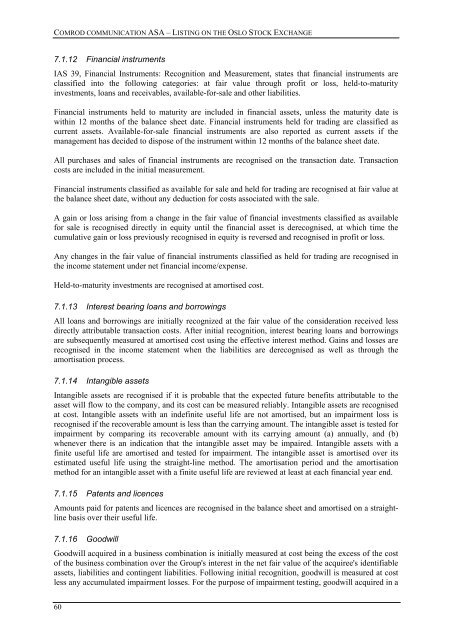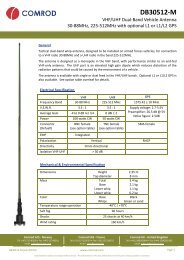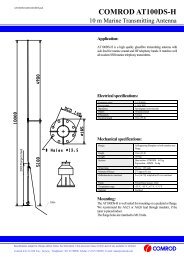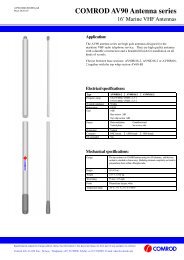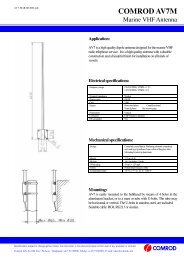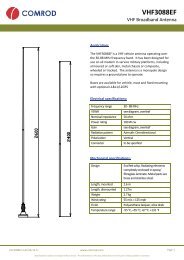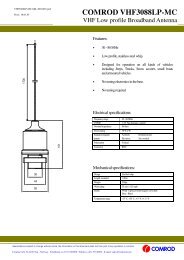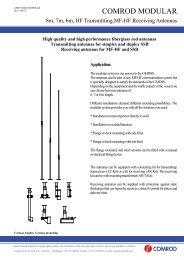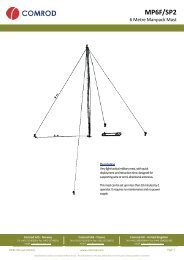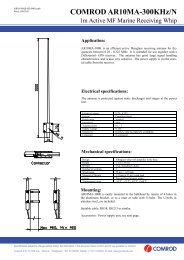English version - Hexagon Composites ASA
English version - Hexagon Composites ASA
English version - Hexagon Composites ASA
Create successful ePaper yourself
Turn your PDF publications into a flip-book with our unique Google optimized e-Paper software.
COMROD COMMUNICATION <strong>ASA</strong> – LISTING ON THE OSLO STOCK EXCHANGE<br />
7.1.12 Financial instruments<br />
IAS 39, Financial Instruments: Recognition and Measurement, states that financial instruments are<br />
classified into the following categories: at fair value through profit or loss, held-to-maturity<br />
investments, loans and receivables, available-for-sale and other liabilities.<br />
Financial instruments held to maturity are included in financial assets, unless the maturity date is<br />
within 12 months of the balance sheet date. Financial instruments held for trading are classified as<br />
current assets. Available-for-sale financial instruments are also reported as current assets if the<br />
management has decided to dispose of the instrument within 12 months of the balance sheet date.<br />
All purchases and sales of financial instruments are recognised on the transaction date. Transaction<br />
costs are included in the initial measurement.<br />
Financial instruments classified as available for sale and held for trading are recognised at fair value at<br />
the balance sheet date, without any deduction for costs associated with the sale.<br />
A gain or loss arising from a change in the fair value of financial investments classified as available<br />
for sale is recognised directly in equity until the financial asset is derecognised, at which time the<br />
cumulative gain or loss previously recognised in equity is reversed and recognised in profit or loss.<br />
Any changes in the fair value of financial instruments classified as held for trading are recognised in<br />
the income statement under net financial income/expense.<br />
Held-to-maturity investments are recognised at amortised cost.<br />
7.1.13 Interest bearing loans and borrowings<br />
All loans and borrowings are initially recognized at the fair value of the consideration received less<br />
directly attributable transaction costs. After initial recognition, interest bearing loans and borrowings<br />
are subsequently measured at amortised cost using the effective interest method. Gains and losses are<br />
recognised in the income statement when the liabilities are derecognised as well as through the<br />
amortisation process.<br />
7.1.14 Intangible assets<br />
Intangible assets are recognised if it is probable that the expected future benefits attributable to the<br />
asset will flow to the company, and its cost can be measured reliably. Intangible assets are recognised<br />
at cost. Intangible assets with an indefinite useful life are not amortised, but an impairment loss is<br />
recognised if the recoverable amount is less than the carrying amount. The intangible asset is tested for<br />
impairment by comparing its recoverable amount with its carrying amount (a) annually, and (b)<br />
whenever there is an indication that the intangible asset may be impaired. Intangible assets with a<br />
finite useful life are amortised and tested for impairment. The intangible asset is amortised over its<br />
estimated useful life using the straight-line method. The amortisation period and the amortisation<br />
method for an intangible asset with a finite useful life are reviewed at least at each financial year end.<br />
7.1.15 Patents and licences<br />
Amounts paid for patents and licences are recognised in the balance sheet and amortised on a straightline<br />
basis over their useful life.<br />
7.1.16 Goodwill<br />
Goodwill acquired in a business combination is initially measured at cost being the excess of the cost<br />
of the business combination over the Group's interest in the net fair value of the acquiree's identifiable<br />
assets, liabilities and contingent liabilities. Following initial recognition, goodwill is measured at cost<br />
less any accumulated impairment losses. For the purpose of impairment testing, goodwill acquired in a<br />
60


